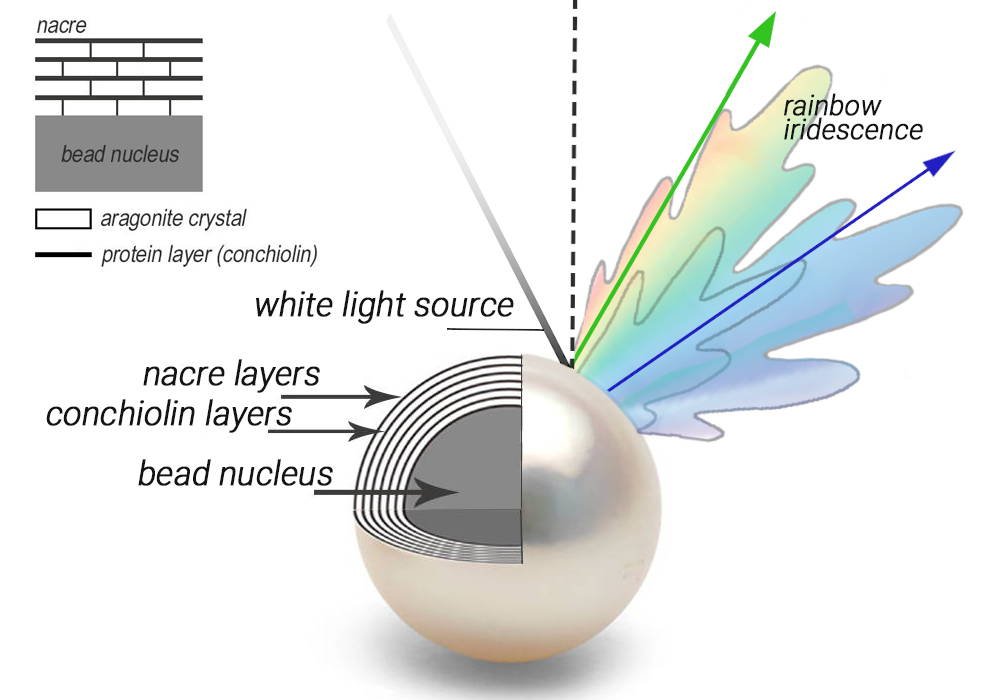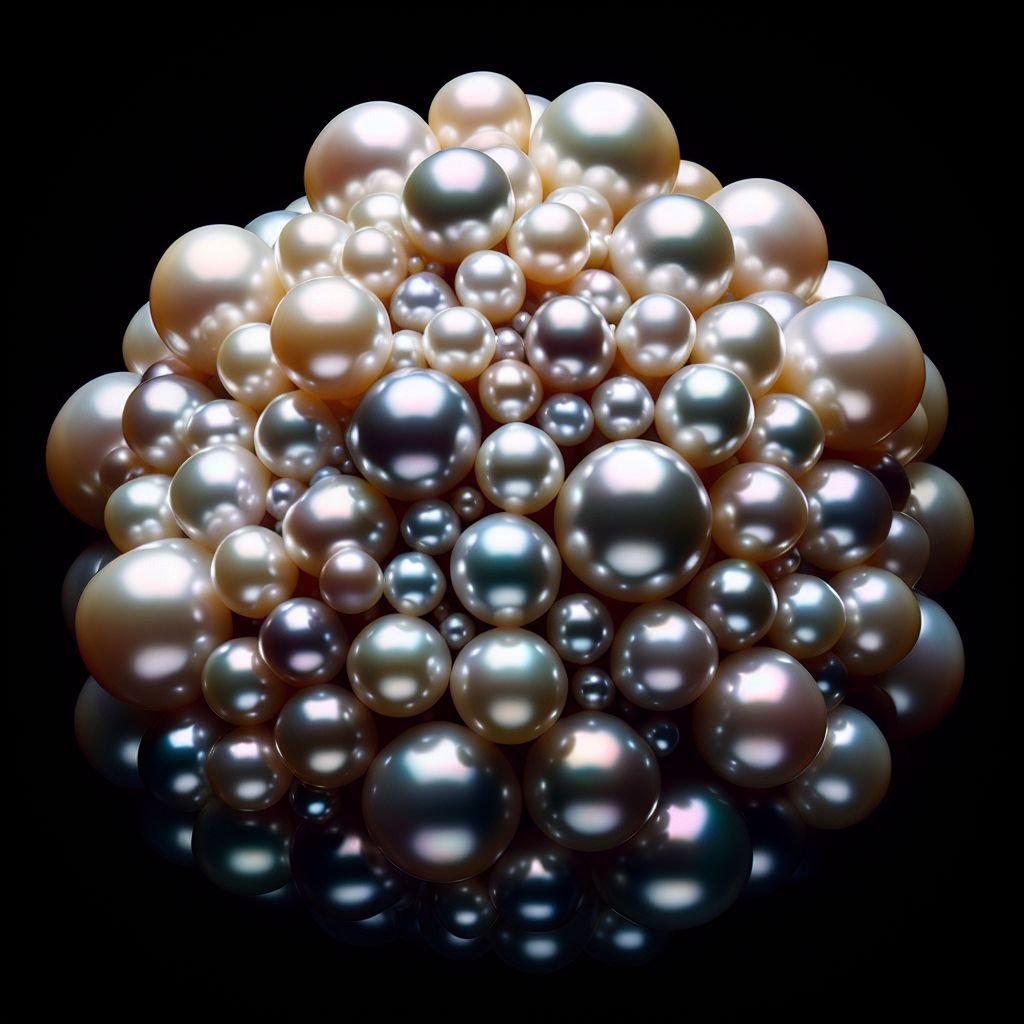Key Takeaways
- Pearl luster is the shine or glow of a pearl, determined by how light interacts with its surface and layers beneath.
- The thickness of nacre, which is the layer of aragonite crystals, is crucial in determining the luster of a pearl.
- Surface quality, including smoothness and cleanliness, directly affects how light reflects off a pearl.
- Environmental factors such as water quality and temperature can influence the development and luster of pearls.
- Proper care and maintenance, like gentle cleaning and avoiding harsh chemicals, help preserve a pearl’s luster over time.
Unveiling the Radiance: The Anatomy of Pearl Luster
Have you ever gazed at a pearl and wondered what makes it so captivating? It’s the luster, that enchanting glow that seems to emanate from within. The luster of a pearl is not just a mere reflection of light; it’s a testament to the pearl’s quality and the conditions in which it was formed. In this article, we’ll delve into the factors affecting pearl luster and how you can appreciate these beautiful gems even more.
What Makes Pearls Shine
The shine of a pearl, often referred to as its luster, is the result of a fascinating play of light. When light hits the surface of a pearl, it penetrates through layers of nacre, the natural substance secreted by oysters. This light then reflects and refracts within these layers, creating the pearl’s signature glow.
However, not all pearls shine the same way. Various factors influence this luster, from the thickness of the nacre to the smoothness of the pearl’s surface. It’s these nuances that determine whether a pearl merely glows or dazzles with brilliance.
The Science Behind Pearl Luster
To truly understand pearl luster, one must grasp the science behind it. At the heart of every pearl is the nacre, composed of microscopic crystals of calcium carbonate arranged in layers. These layers are what give a pearl its luster. The more layers there are, the more opportunities light has to bounce around and create that mesmerizing effect.
Imagine each layer as a tiny mirror. The more mirrors you have, the more light gets reflected back, enhancing the pearl’s shine. Therefore, pearls with thicker nacre often exhibit superior luster compared to those with thinner nacre. Besides that, the quality of these layers, such as their uniformity and smoothness, also plays a significant role in determining how lustrous a pearl appears.
Key Factors Affecting Pearl Luster
Nacre Thickness and Its Role


“What is nacre ? – Seven Seas Pearls” from sevenseaspearls.com and used with no modifications.
The thickness of nacre is arguably the most critical factor affecting pearl luster. As the oyster secretes layer upon layer of nacre over time, the thickness increases, enhancing the pearl’s ability to reflect light. Thicker nacre not only contributes to better luster but also indicates a more durable pearl.
For example, South Sea pearls are known for their thick nacre, which often results in exceptional luster. In contrast, pearls with thinner nacre may appear duller and are more susceptible to damage. Therefore, when evaluating pearls, always consider the nacre thickness as a primary indicator of quality.
Surface Quality and Light Reflection
Surface quality is another pivotal element that affects a pearl’s luster. A smooth, blemish-free surface allows light to reflect evenly, enhancing the pearl’s shine. On the other hand, pearls with rough or pitted surfaces scatter light, resulting in a less lustrous appearance.
When inspecting pearls, look for clear and sharp reflections on the surface. This clarity is a sign of excellent surface quality and, consequently, high luster. Pearls with excellent surface quality are not only visually appealing but also more valuable in the market. For more insights on pearl quality, explore the Akoya pearl grading standards.
- Examine the pearl under natural light for the best assessment.
- Look for clear, mirror-like reflections.
- Avoid pearls with chalky or dull surfaces.
Environmental Influences on Pearl Luster
Environmental conditions play a significant role in determining the luster of a pearl. Factors such as water temperature, salinity, and cleanliness can all impact the quality of the nacre and, by extension, the pearl’s luster.
For instance, pearls cultivated in clean, nutrient-rich waters tend to develop thicker, more lustrous nacre. Conversely, pearls grown in polluted or overly warm waters may suffer from thin or uneven nacre layers, resulting in diminished luster. For more insights on maintaining pearl quality, explore our pearls luster management guide.
The Art of Evaluating Pearl Luster
Evaluating the luster of pearls is both an art and a science. While the beauty of a pearl can be subjective, certain criteria are universally recognized in assessing luster. Whether you’re a seasoned jeweler or a budding enthusiast, understanding these standards can help you make informed decisions when purchasing pearls.
Grading Systems and Standards
Grading systems for pearls vary, but most include luster as a key component. Generally, pearls are graded on a scale ranging from excellent to poor. An excellent luster means the pearl has sharp, bright reflections and a deep glow. On the other end, a pearl with poor luster will appear chalky and have blurry reflections.
One popular grading system is the AAA-A scale, where AAA denotes the highest quality. Pearls graded AAA have excellent luster, with minimal surface blemishes. As the grade decreases, so does the quality of the luster and the presence of surface imperfections. This grading system helps buyers understand what to expect in terms of shine and overall appearance.
Identifying High-Quality Luster in Pearls
Spotting high-quality luster involves a keen eye and attention to detail. When evaluating pearls, pay close attention to how light interacts with their surface. High-quality luster is characterized by sharp, mirror-like reflections and a vibrant glow that seems to come from within the pearl. For a comprehensive guide on managing pearl luster, you can refer to this luster management guide.
To test a pearl’s luster, hold it under a direct light source and observe the reflections. A pearl with excellent luster will reflect light clearly and brightly, almost like a tiny mirror. Additionally, the surface should appear smooth and free from significant blemishes, which can detract from the pearl’s ability to reflect light effectively.
Comparing Luster Across Different Pearl Types
Not all pearls are created equal when it comes to luster. Different types of pearls exhibit varying levels of shine due to their unique formation processes. For instance, Akoya pearls are renowned for their exceptional luster, often described as having a reflective, metallic-like quality.
In contrast, South Sea pearls, while known for their size and color, may have a softer luster. This difference arises because of the thicker nacre layers, which diffuse light more gently. Freshwater pearls, on the other hand, can vary widely in luster, depending on the farming techniques and environmental conditions in which they are grown.
Caring for Your Pearls to Preserve Luster
Preserving the luster of your pearls is essential to maintaining their beauty and value. With proper care and attention, pearls can retain their shine for generations. Here are some tips to ensure your pearls continue to dazzle.
Cleaning and Storage Tips
Cleaning pearls requires a gentle touch. Always use a soft, damp cloth to wipe them clean after wearing, as sweat and oils from your skin can dull their luster over time. Avoid using harsh chemicals or ultrasonic cleaners, as these can damage the nacre.
- Store pearls in a soft pouch or lined jewelry box to prevent scratches.
- Keep them away from other jewelry that may cause abrasion.
- Ensure pearls are dry before storing to prevent moisture damage.
Protecting Pearls from Damage
Pearls are delicate and can be easily damaged if not handled with care. To protect them, avoid exposing pearls to harsh chemicals found in household cleaners, perfumes, and hair products. Always put on pearls after applying cosmetics to minimize contact with these substances.
Additionally, avoid wearing pearls in water, whether swimming or showering, as prolonged exposure can weaken the nacre. Regularly inspect your pearl jewelry for signs of wear or damage, and have them restrung if necessary to prevent loss or breakage.
By following these guidelines, you can ensure your pearls maintain their luster and continue to be a cherished part of your jewelry collection. For more detailed advice, consider exploring our Pearls Luster Management Guide.
Avoiding Chemicals and Harsh Environments
To keep your pearls looking their best, it’s crucial to avoid exposing them to chemicals and harsh environments. Pearls are organic gems, making them susceptible to damage from substances like perfume, hairspray, and cleaning agents. These chemicals can erode the nacre, dulling the luster over time.
Always apply your cosmetics, perfume, and hairspray before putting on your pearls. This simple step can significantly reduce the risk of damage. Additionally, avoid wearing pearls in situations where they might come into contact with chlorine or saltwater, such as swimming pools or the ocean. Both can be harmful to the delicate surface of pearls. For more information, you can explore this article on understanding pearl luster.
Final Thoughts on Pearl Luster Importance
Pearl luster is more than just a visual attribute; it’s a testament to the pearl’s quality and the care taken in its creation and maintenance. Whether you’re selecting a new piece for your collection or caring for a treasured heirloom, understanding the factors that influence luster can help you appreciate the true value of these timeless gems.
By focusing on nacre thickness, surface quality, and proper care, you can ensure your pearls remain as luminous and captivating as the day they were first formed. Remember, a well-cared-for pearl not only retains its beauty but also its value, making it a worthy investment for any jewelry enthusiast.
Frequently Asked Questions (FAQ)
What is the difference between freshwater and saltwater pearl luster?
Freshwater and saltwater pearls differ primarily in their formation process and the environment in which they grow. Saltwater pearls, such as Akoya and South Sea pearls, often have a more pronounced luster due to the thicker nacre layers and the specific conditions of the ocean. Freshwater pearls, cultivated in rivers and lakes, can vary widely in luster. While some may have a brilliant shine, others might appear softer or more subdued.
How does nacre thickness affect pearl value?
Nacre thickness is a crucial factor in determining a pearl’s value. Thicker nacre not only enhances luster but also indicates durability, making such pearls more desirable and valuable. In contrast, pearls with thin nacre might lack the same level of shine and are more prone to damage over time.
- Thick nacre equals better luster and durability.
- Thin nacre may result in a duller appearance.
- Thicker nacre generally means higher value.
Therefore, when purchasing pearls, it’s essential to inquire about the nacre thickness to ensure you’re getting a quality piece.
Can pearl luster diminish over time?
Yes, pearl luster can diminish if not properly cared for. Exposure to chemicals, physical damage, and improper storage can all contribute to a loss of luster. However, with regular maintenance and careful handling, you can preserve a pearl’s shine for many years. For more information, check out our Pearls Luster Management Guide.
What is the best way to clean pearls?
Cleaning pearls requires a gentle approach. After wearing, wipe them with a soft, damp cloth to remove oils and dirt. Avoid harsh chemicals or abrasive materials that could damage the nacre.
For a deeper clean, you can use a mild soap solution. Dip a soft cloth into the solution, gently wipe the pearls, and then rinse with a clean, damp cloth. Always dry your pearls thoroughly before storing them to prevent moisture damage.
By following these cleaning guidelines, you can maintain your pearls’ luster and keep them looking their best for generations to come.



